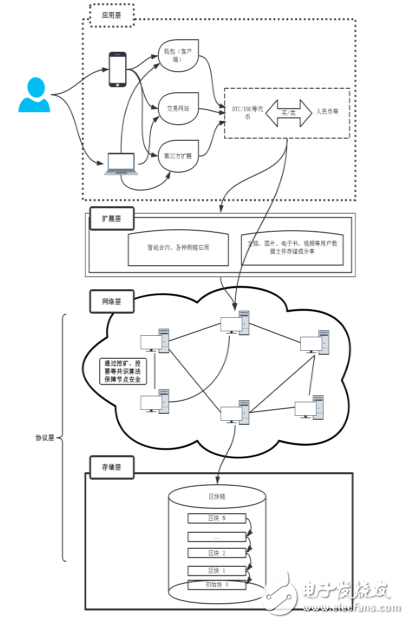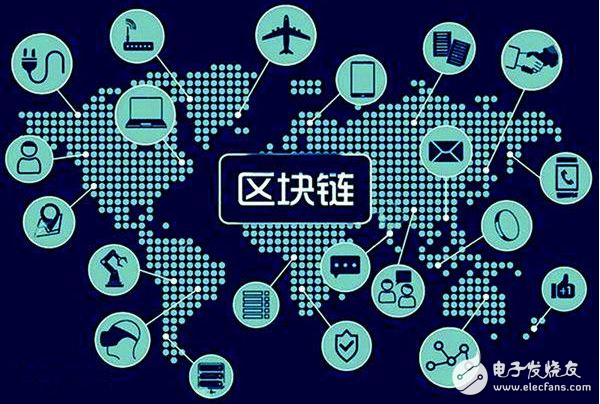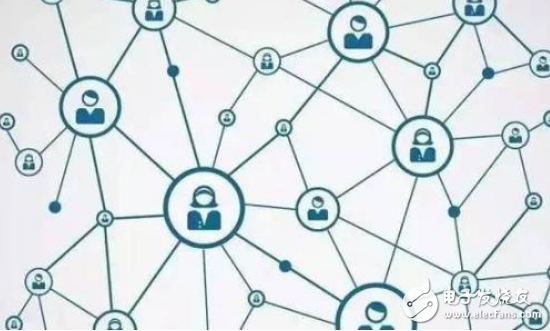Blockchain is a new application mode of computer technology such as distributed data storage, point-to-point transmission, consensus mechanism, and encryption algorithm. The so-called consensus mechanism is a mathematical algorithm for realizing trust and acquiring rights between different nodes in the blockchain system.
Blockchain is an important concept of Bitcoin. The currency is linked to the Internet Finance Lab of Wudaokou Finance College of Tsinghua University and the “2014-2016 Global Bitcoin Development Research Report†released by Sina Technology. The blockchain is bitcoin. The underlying technology and infrastructure. Essentially a decentralized database, as the underlying technology for Bitcoin. A blockchain is a string of data blocks generated using cryptographic methods. Each block contains information about a bitcoin network transaction for verifying the validity of its information (anti-counterfeiting) and generating the next block.
Blockchain technology logicThe blockchain can be easily divided into three levels, the protocol layer, the extension layer, and the application layer. Among them, the protocol layer can be divided into a storage layer and a network layer, which are independent but inseparable. Figure:

The so-called protocol layer refers to the lowest level of technology. This level is usually a complete blockchain product, similar to our computer's operating system, which maintains network nodes and only provides Api for calls. Usually the official will provide a simple client (known as the wallet), this client wallet is also very simple, can only establish the address, verify the signature, transfer payment, check the balance and so on. This level is the foundation of everything. It builds the network environment, builds the trading channel, and formulates the node reward rules. As for what you want to trade and what you want to do, it can't be asked. A typical example is Bitcoin, and there are various second-generation coins, such as Litecoin. The book is also introduced in the book. This level is where the developers gather at this stage, which shows that the cryptocurrency is still in its infancy.
From the technology used, the protocol layer mainly includes four aspects: network programming, distributed algorithm, cryptographic signature, data storage technology, etc. Among them, network programming ability is the main consideration for everyone to choose programming language, because distributed algorithm basically It is a business logic implementation, what language can be done, cryptographic signature technology is straightforward to use (please read the relevant encryption and decryption articles in the book, it is not recommended to play freely, there is not too much coding logic), database technology is also mainly At the use level, only the implementation of peer-to-peer network and concurrent processing is the difficulty of development. Therefore, people who have strong network programming ability and simple concurrent processing are particularly preferred. As a result, Nodejs development blockchain applications have gradually become more popular, and the Go language is gradually emerging.

I further divided this level into the storage layer and the network layer. Data storage can be relatively independent, with a greater degree of freedom of choice, which can be discussed separately. The principle of choice is nothing more than performance and ease of use. We know that the overall performance of the system depends mainly on the I/O performance of the network or data storage. The network I/O optimization space is not large, but the I/O of the local data storage can be optimized. For example, Bitcoin chose Google's LevelDB, which is said to have good read and write performance, but many features need to be implemented by developers themselves. At present, a major problem that plagues the industry is that cryptocurrency transactions are far less processed than today's centralized payment systems (banks, etc.), except for I/O, which requires a full range of breakthroughs.
Distributed algorithms, cryptographic signatures, etc. must be used in the process of implementing peer-to-peer networks, so it is naturally a matter of the network layer, and also the focus and difficulty of coding. The "Nodejs Development of Cryptographic Money" book is basically the content of this part. . Of course, there are also separate implementations of the peer-to-peer network, which separates the logic of node lookup, data transmission, and verification, and puts together the operations of consensus algorithms, cryptographic signatures, and data storage to form the core layer. No matter how it is combined, these two parts are the core and lowest part, and they are the content of the protocol layer.
Expansion layerThis level is similar to the computer driver, in order to make the blockchain products more practical. At present, there are two types, one is the various trading markets, which is an important channel for the exchange of legal currency into cryptocurrency. It is simple to implement, fast in money, low in cost, but also risky. The second is to achieve the expansion of a certain direction, such as based on the billion side chain, can provide customized services for third-party publishers, forum sites and other content producers. Especially worth mentioning is the concept of “smart contract†that everyone hears the most. This is a typical application development at the extended level. The so-called "smart contract" is "programmable contract", or "contract intelligence", in which "smart" is the intelligence of execution, that is to say, to achieve certain conditions, the contract is automatically executed, such as automatic transfer of securities, automatic payment Etc. At present, there is no comparatively shaped product, but it is undeniable that this will be an important development direction of blockchain technology.

There is no limit to the technology used by the extension layer. It can include many of the above mentioned distributed storage, machine learning, VR, Internet of Things, big data, etc., can be used. The choice of programming language can be more free, because it can be completely separated from the protocol layer, and the programming language can be different from the development language used by the protocol layer. In development, in addition to interacting with the protocol layer during transactions, try not to mix with the development of the protocol layer. This level is closer to the application layer, and can also be understood as the server in the B/S architecture. This not only makes the architecture design more scientific, but also makes the blockchain data smaller, the network more independent, and also ensures that the extension layer development is not constrained.
From this perspective, the blockchain can be structured to develop any type of product, not just in the financial industry. In the future, with the improvement of the underlying protocol, any product that requires third-party payment can conveniently use the blockchain technology; any information that needs to be confirmed, credited, and traced can be realized by means of a blockchain. I personally feel that this goal should be achieved soon.
Application layerThis level is similar to the various software programs in the computer. It is a product that can be used directly by ordinary people. It can also be understood as a browser in the B/S architecture. This level of application is currently almost blank. The market is in urgent need of such an application, detonating the market, forming a real expansion trend, allowing the blockchain technology to quickly enter the ordinary people and serve the public. The various light wallets (clients) that you use should be counted as the simplest and most typical application in the application layer. Soon, Yishu will launch a document collaboration tool based on Yishu.com, which is a typical application layer product.

Limited to the current development of blockchain technology, Yishu can only start from the protocol layer and point the target to the application layer, while providing third-party developers with strong support for the extension layer. This can not only avoid greed, but also avoid the failure to land. It is a truly rational development route. Because of the pure development protocol layer or extension layer, it is impossible to truly understand and verify the application layer, which is out of the real world and makes it difficult for third-party developers to use. If you only consider the application layer, you can't find a really strong, easy-to-use protocol layer or extension layer. Therefore, we have to make full efforts, adopt a completely open source and open attitude, and work together to do a meaningful thing through the power of the community. It can also be regarded as a technical accumulation and meager contribution to the development of China's blockchain technology.
Blockchain technology principleToday's blockchain technology is summed up as a technology that collectively maintains a reliable database through decentralization and trust. In fact, blockchain technology is not a single, new technology, but the result of the integration of a variety of existing technologies (such as encryption algorithms, P2P file transfer, etc.), these technologies and database are skillfully combined to form A new way of data recording, delivery, storage and presentation. Simply put, blockchain technology is a technology that everyone participates in to record information and store information. In the past, people handed over the work of data recording and storage to a centralized organization, and blockchain technology allowed everyone in the system to participate in the recording and storage of data. The blockchain technology constructs a P2P self-organizing network using a distributed collective operation method under a distributed peer-to-peer network without a central control point. Through a complex verification mechanism, the blockchain database can maintain integrity, continuity and consistency. Even if some participants falsify, they cannot change the integrity of the blockchain, nor can they tamper with the data in the blockchain. Key points involved in blockchain technology include: decentralization, collective maintenance, timestamps, reliable databases, de-trust, asymmetric encryption, and more.

Blockchain technology redefines the way credit is generated in the network: in the system, participants do not need to know other people's background information, and do not need the guarantee or guarantee of third-party organizations. Blockchain technology guarantees the system's value transfer. The activities are recorded, transmitted, and stored, and the final result must be credible.
The source of the blockchain technology principle can be summed up as a mathematical problem: the Byzantine general. The problem of General Byzantine extends to the life of the Internet. The connotation can be summarized as follows: In the context of the Internet, how can people be prevented from being deceived by vandals when they need value exchange activities with unfamiliar counterparties? Confused to make the wrong decision. Further extending the Byzantine general issue to the technical field, its connotation can be summarized as: how the various nodes distributed in the network should reach consensus in the absence of a trusted central node and a trusted channel. Blockchain technology solves the long-standing problem of General Byzantine—a way to create a consensus network without having to trust a single node.
Customizable Fever Piece,Fever Piece PE Film,No Burr Fever Piece
SHAOXING HUALI ELECTRONICS CO., LTD. , https://www.cnsxhuali.com